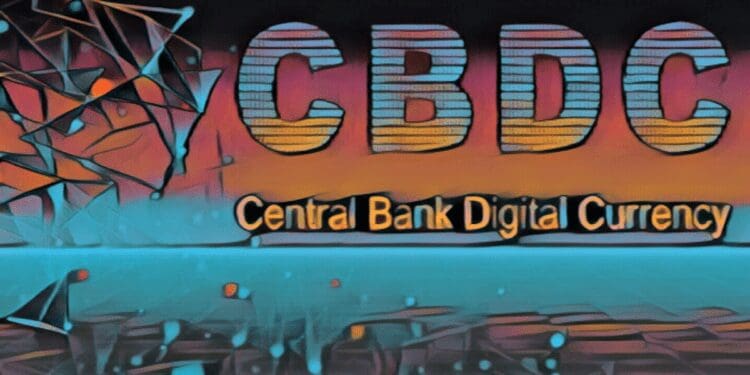CBDC, or central bank digital currency, is a virtual currency backed and issued by a central bank. As stablecoins and cryptocurrencies have grown in popularity, central banks worldwide have realized that they must provide an alternative to physical money or risk missing out on the future of money.
Thousands of digital currencies, also called cryptocurrencies, have already been made. Cryptocurrencies may be centralized; however, the government doesn’t issue them. You can consider the Diem project, which was started by Facebook. But Bitcoin and its competitors are a few examples of decentralized cryptocurrencies.
Cryptocurrencies depend on distributed ledger technology (DLT), which says that a transaction’s accuracy is constantly validated by global devices rather than a single central hub.
CBDC is managed on a digital ledger, thereby speeding up and securing the payments between institutions, banks, and individuals.
Moreover, digital currencies issued by central banks are one of the most revolutionary innovations in the global financial ecosystem. There are many questions about Crypto vs. CBDC discussions in the financial world. Now, let’s look at different concepts regarding CBDCs and compare central bank digital currencies and cryptocurrencies.
What is the Point of CBDCs?

Cryptocurrencies have been stopped due to their ability to bring a new world of global financial inclusivity and simplified financial services infrastructure. But, their prominence stems from their capacity as a store of value rather than a medium of exchange. This chasm is closing over time, with commercial entities and monetary authorities issuing stabilized cryptocurrencies and CBDCs as viable mainstream payment options.
Furthermore, the main concept of cryptocurrency revolved around for more than a quarter-century. Central agencies were the initial ones to issue cryptocurrencies such as e-gold and Digicash.
Nevertheless, BTC’s introduction in the year 2009 changed this model considerably in two ways: establishing a decentralized ledger for record-keeping and transaction execution and creating a currency independent of any sovereign monetary authority.
The rising significance of digital currency during the pandemic, the shift to digital payments, ambitions to employ foreign CBDCs in cross-border transfers, and concerns about financial exclusion are all converting CBDCs into sharper attention.
The competition for delivery of the first genuine digital money version is increasing in central banks globally. For example, China is experimenting with a digital Renminbi allowing users to make payments using their smartphones.
Similarly, as part of the 5-year plan, Europe announced the creation of a digital euro. The COVID-19 pandemic rushed the change to contactless transactions, focusing on the importance of everyone having access to safe, rapid, and low-cost payments.
The Federal Reserve is also increasing its public engagement and research on central bank cryptocurrencies in light of tech platforms integrating digital private money into the US payments system and foreign authorities studying the possibilities for CBDCs in cross-border payments.
CBDCs appear to be more than merely a digital-native replica of traditional coins and notes, according to many public statements. Some governments see CBDCs as programmable money, vehicles for social policy, and money that may limit their use to fundamental necessities, particular regions, or defined periods. Additionally, the solving the challenge of more detailed financial inclusion.
CBDC can take many shapes, each having many implications for monetary policy transmission, payment systems, and the financial system’s stability and structure.
Main Features of CBDCs

A CBDC should have institutional characteristics, systems, and instruments.
It focuses on the interactions of 4 major parts:
- Form (physical or digital)
- Issuer (central bank)
- Technology (account-based or token)
- Issuer (central bank)
Money is generally based on one of two technologies: Accounts or stored-value tokens. Cash and many cryptocurrencies depend on tokens, whereas reserve account balances and commercial bank money depend on accounts.
Types of CBDCs
- General-purpose CBDCs
- Wholesale only CBDCs
| General purpose CBDCs | Wholesale only CBDCs | |
| Purpose | Meant for average consumers and the public to perform regular transactions. | Meant for trading and exchanging among central banks and private banks. |
| Suitability | Central banks in rising economies | Central banks in advanced economies |
| Benefits | Availability, traceability, and anonymity. | Fast cross-border transactions |
CBDC vs. Cryptocurrency
| CBDCs | Cryptocurrencies | |
| Blockchain type | Permissioned blockchains (private) | Permissionless blockchains (public) |
| Anonymity | Lined to an existing bank account and the corresponding amount of personal info | Anonymous |
| Structure | Centralized | Decentralized |
| Usage | Payment and other monetary transactions | Speculation and payments |
Pros and cons of CBDCs
PROS
- CBDCs create government functions and monetary policy easier to implement.
- They use wholesale CBDCs to automate the process between the retail and banks or general purpose CBDCs to directly connect central banks and customers.
- Government services like distributing benefits and collecting taxes and calculations benefit from these digital currencies by decreasing processes and work.
- Money is disbursed via intermediaries, introducing a third-party risk into the transaction.
What happens if the bank’s cash deposits run out?
CONS
- They sometimes need to give solutions to the problem of centralization. The authority for conducting the transactions is still delegated to and vested in a central authority. Resultantly, it affects transaction lever and data between banks and citizens.
- As the administrator is in charge of disseminating and collecting crypto identifications.
- Users would have some privacy issues.
- Each transaction would be available to the service provider leading to privacy issues similar to those of ISPs and IT giants.
Wrapping up
The CBDCs disrupt the fractional reserve system, enabling commercial banks to create money by lending more than they have in liquid deposits. Deposits are needed by banks for them to make investment decisions and make loans.
Conventional banks become “Loanable funds intermediaries,” long-term lending funds to finance long-term loans such as mortgages if all private bank deposits were transferred into CBDCs.
Mainly, a narrow banking system overseen by the central bank would replace the fractional-reserve banking system. This would count for the financial revolution, one of the many advantages. Central banks are considered better equipped for preventing bank runs and monitoring private banks’ risky lending/credit choices.
A well-formed CBDC will be a safe and impartial settlement and payment asset, acting as a shared interoperable platform for the new payment ecosystem to organize itself.













Discussion about this post